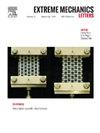极端静水压力下耐压柔性系统的设计与优化
IF 4.5
3区 工程技术
Q2 MATERIALS SCIENCE, MULTIDISCIPLINARY
引用次数: 0
摘要
近年来,软体机器人越来越多地发展和部署到深海应用中。与传统的水下机器人依赖于笨重的压力容器来保护不同,一些软机器人可以利用聚合物封装的方法直接暴露在静水压力下。该方法优化了软机器人中电子元件的结构,以消除高压接口,但由于其复杂性,仍然缺乏明确的设计指南。本文介绍了一种耐压电子器件的设计方法;利用Eshelby包含理论和有限元分析。提出了一种用于数值优化的几何相干指数κ来评价PCB元件的排列。计算和仿真表明,优化后的电路板元件在高静水压力下的最大和平均剪切应力均降低了45.5% %。一个电路板原型已经制造出来,然后在马里亚纳海沟10,900 米的深度进行测试。现场试验证实了该方法的有效性,显示了其改进深海勘探技术的潜力。本文章由计算机程序翻译,如有差异,请以英文原文为准。
Design and optimization of pressure-tolerant flexible systems under extreme hydrostatic pressure
Soft robots have been increasingly developed and deployed for deep-sea applications in recent years. Unlike traditional underwater robots that rely on bulky pressure vessels for protection, some soft robots can be directly exposed to hydrostatic pressure utilizing a polymer-encapsulation approach. This approach optimizes the structure of electronic components in soft robots to eliminate high-pressure interfaces, yet clear design guidelines remain absent due to its complexity. This paper introduces a design methodology for pressure-tolerant electronics; that leverages the Eshelby inclusion theory and finite element analysis. A parameter κ called the geometric coherence index for numerical optimization is proposed to evaluate the arrangement of PCB components. Calculations and simulations have demonstrated that the optimized circuit board components exhibit a reduction of up to 45.5 % in both maximum and average shear stress under high hydrostatic pressure. A circuit board prototype has been manufactured and then tested at a depth of 10,900 m in the Mariana Trench. Field tests have confirmed the effectiveness of this method, demonstrating its potential for improving deep-sea exploration technologies.
求助全文
通过发布文献求助,成功后即可免费获取论文全文。
去求助
来源期刊

Extreme Mechanics Letters
Engineering-Mechanics of Materials
CiteScore
9.20
自引率
4.30%
发文量
179
审稿时长
45 days
期刊介绍:
Extreme Mechanics Letters (EML) enables rapid communication of research that highlights the role of mechanics in multi-disciplinary areas across materials science, physics, chemistry, biology, medicine and engineering. Emphasis is on the impact, depth and originality of new concepts, methods and observations at the forefront of applied sciences.
 求助内容:
求助内容: 应助结果提醒方式:
应助结果提醒方式:


